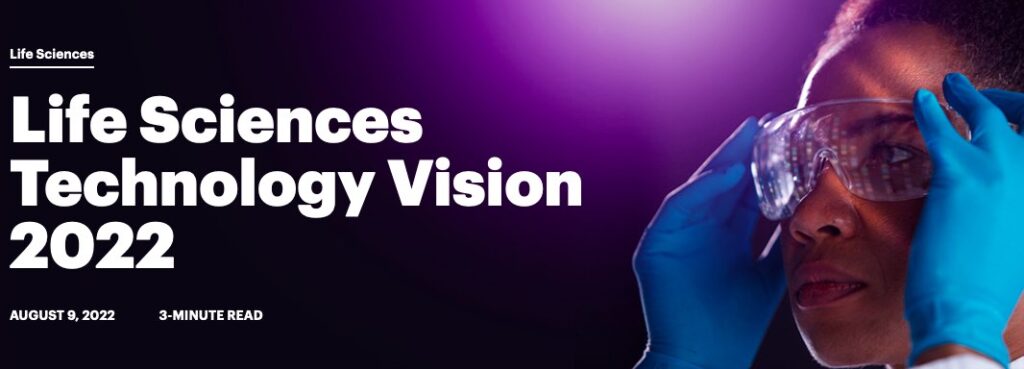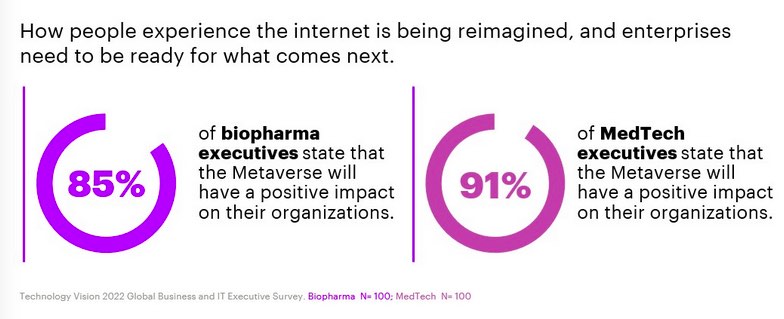
Accenture hat kürzlich die “Accenture Metaverse Continuum Business Group” ins Leben gerufen, um Life-Science-Unternehmen bei der Gestaltung, Durchführung und Beschleunigung ihrer Metaverse-Journeys zu unterstützen.
In dem Bericht Life Sciences Technology Vision 2022 Report von accenture werden vier Technologietrends untersucht, die das Metaverse-Kontinuum untermauern.
Das Metaverse ist ein sich entwickelndes und expandierendes Kontinuum in mehreren Dimensionen – digital und physisch – welche Technologien wie Extended Reality, Blockchain, künstliche Intelligenz, digitale Zwillinge, nicht fungible Token und intelligente Geräte umfasst.
Grosse Erwartungen an das Metaversum
Dem Bericht zufolge erwarten führende Biowissenschaftler (91 % der Führungskräfte in der Medizintechnik und 85 % der Biopharma-Führungskräfte), dass sich das Metaverse positiv auf ihre Organisationen auswirken wird, und fast die Hälfte der befragten Biopharma-Führungskräfte glaubt, dass das Metaverse einen Durchbruch oder eine transformative Wirkung haben wird auf ihre Organisationen.

Petra Jantzer, Global Industry Life Sciences Lead bei Accenture, sagte:
„Wir befinden uns in den Anfängen des Metaversums und der Technologieinnovationen, die wir heute implementieren – die Lösungen, Produkte und Dienstleistungen, die Unternehmen anbieten, wie sie sie entwickeln und vertreiben und wie sie ihre Organisationen grundlegend betreiben – sind die Bausteine der Zukunft für die Biowissenschaften. Branchenführer leisten Pionierarbeit für eine neue digitale Zukunft für die Interaktion von Menschen und Unternehmen, und viele der Regeln bleiben undefiniert. Es ist entscheidend, dass Biowissenschaftsunternehmen proaktive Schritte unternehmen und das Metaverse-Kontinuum verantwortungsvoll gestalten.“
Vier Technologietrends gem. Accenture
Trend 1: WebMe
Putting the Me in Metaverse.
WebMe explores how the internet is being reimagined. The last two years have spurred enterprises to explore new modes of digital experience and pushed people to live virtually to an extent they never expected. Now the metaverse is emerging as a natural evolution that reconciles how the internet is designed today, with what we will demand from it going forward. The advent of the metaverse, and underlying efforts to reimagine how data shapes our digital experiences, will challenge businesses to rethink their presence online and become a part of shaping the next platform revolution as they build new ways to connect to customers, partners and their digital workforce.
Trend 2: The Programmable World
Our Planet, Personalized
The Programmable World tracks how technology is being threaded through our physical environments in increasingly sophisticated ways. It projects how the convergence of 5G, ambient computing, augmented reality, smart materials, and more are paving the way for businesses to reshape how they interact with the physical world. As technology becomes part of the fabric of our environment, it allows us to treat our environment more like technology—unlocking an unprecedented fidelity of control, automation, and personalization.
Trend 3: The Unreal
Making Synthetic, Authentic
The Unreal is a trend where our environments and businesses are increasingly filled with machines that are passably human. “Unreal” qualities are becoming intrinsic to AI, and the data, that enterprises aspire to integrate into mission-critical functions. At the same time, people are coming face-to-face with bad actors using this technology—from deepfakes to bots and more—igniting a growing concern that may turn into the biggest hurdle for enterprises looking to grow their use of AI. Like it or not, enterprises have been thrust into the forefront of a world questioning what’s real, what isn’t, and if the line between those two really matters.
Trend 4: Computing the Impossible
New Machines, New Possibilities
We are on the precipice of resetting the boundaries of traditional industries as we begin computing the impossible. The outer limit of what is computationally possible is being disrupted as a new class of machines emerges. Quantum, biologically inspired, and high-performance computers are each allowing companies to tackle grand challenges that once defined and shaped the very core of their industries. As problems once considered impossible become ever more solvable, business leaders will be pushed to reimagine how to harness the next generation of computing power.
Den hochinteressanten Report “Life Sciences Technology Vision 2022” erhalten Sie
hier.
Abbildungen: Courtesy of accenture
Quelle: accenture, 22. August 2022
